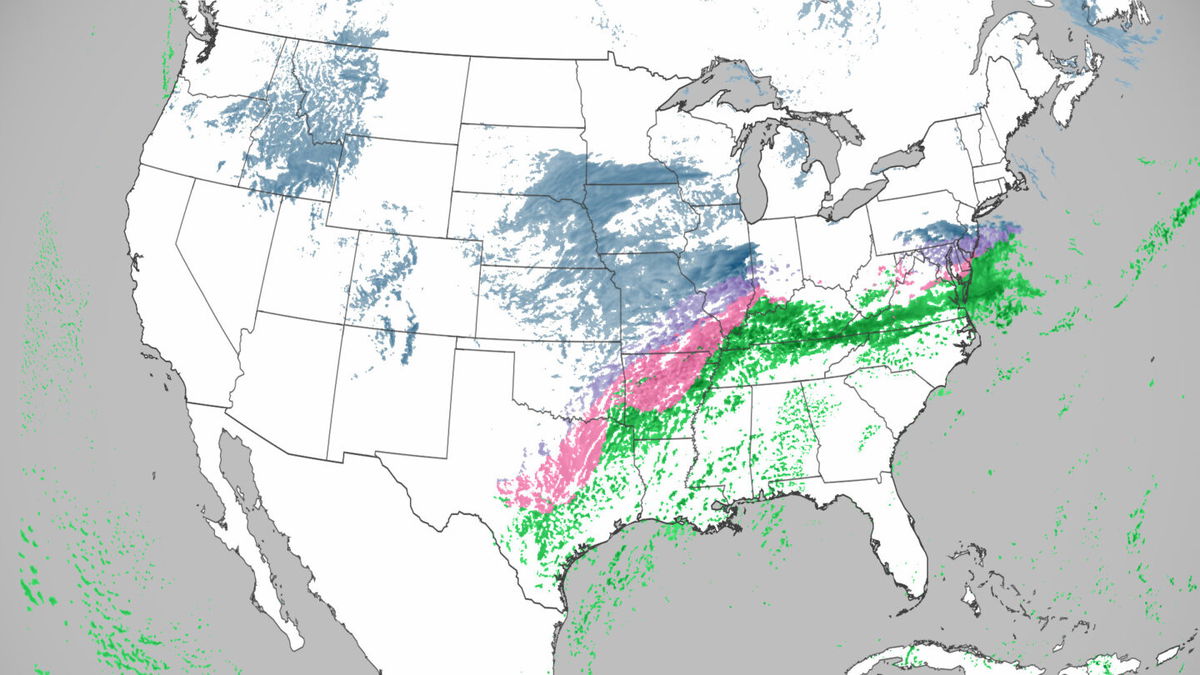A dangerous ice storm is developing as cold and warm temperatures clash

By Caitlin Kaiser and Judson Jones, CNN
As the second storm of the week sweeps across the US, clashing temperatures will cause dangerous winter weather to emerge across the country, with ice becoming a concern.
It might seem like déjà vu in regard to a storm dropping a wintry mix and heavy rain across the US earlier this week. And in many ways, it is.
However, the new storm is bringing more substantial amounts of ice. Ice accumulation totals associated with the storm pose a major threat to travel and infrastructure in areas across the central US to the Northeast.
Sign up to get forecast and weather news from our meteorologists in your inbox
“Significant ice accumulations greater than 0.25″ are likely from the Red River Valley of Texas through the Ozarks and southeast Missouri. Locally, damaging ice of 0.5″ or more is possible which could lead to scattered power outages, tree damage, and dangerous travel,” the Weather Prediction Center (WPC) tweeted.
The south-central US is the bull’s-eye for ice accumulation, looking at possible totals of up to three-quarters of an inch across areas of northeast Arkansas Thursday, creating hazardous conditions.
“Travel could be nearly impossible,” the National Weather Service (NWS) office in Little Rock cautioned.
It might not feel like it today, but the Northeast is not out of the woods either, as a similar wintry mix is headed their way Friday.
As the system moves across the Great Lakes region overnight Thursday and into southern New England early Friday, heavy snow and significant ice are expected.
South-central Pennsylvania and western Maryland could see ice accumulations of up to a quarter of an inch. Although they may be more accustomed to winter weather, “widespread hazardous travel and damage to the power infrastructure are expected,” the WPC warned.
Six inches of snow or more is expected across much of the Northeast and southern New England, with areas of Massachusetts likely to see almost a foot of snow. Boston is forecast to see around nine inches by the end of the week.
New York City is projected to see around two and a half inches of snow Thursday night, transitioning into a wintry mix and eventually into rain Friday.
The low-pressure system delivering an icy mix from Texas to New York is also dropping feet of snow across the Rockies Wednesday, causing concern for avalanches. Some areas in higher elevations could see up to 4 feet of snow from the storm. Large amounts in the higher elevations of Colorado led the Colorado Avalanche Information Center to issue avalanche warnings from Wednesday to Thursday morning.
“Very dangerous avalanche conditions exist in the backcountry. Heavy snow and strong winds will result in natural avalanches,” the Center said.
Strong winds will also make it feel even colder than it already is.
This winter storm is looking to break temperature records on both ends of the spectrum
Temperatures across much of the Rockies, Plains, and Mississippi Valley are dropping drastically, ranging from 20-40 degrees below average, according to the WPC. Low temperatures are looking to equal or edge out previous cold daily temperature records.
More than 10 million people are currently under wind chill advisories and warnings, stretching over 14 states. Areas across the Plains are experiencing life-threatening conditions with wind chills ranging from -30 to -50 degrees.
“The dangerously cold wind chills could cause frostbite on exposed skin in as little as 10 minutes,” the NWS in Bismark, ND, said.
However, East Coast temperatures are telling a different story.
Check when your town is likely to dip below freezing
“In contrast, temperatures will be 10 to 20 degrees above average over most of the East Coast, with several locations having record-breaking or tied high temperatures from Wednesday into Thursday morning,” the WPC said.
An extreme difference in temperatures creates the perfect environment for ice storms.
“When warm, humid air and cold air try to occupy the same real estate, ice storms happen. The frigid Arctic air is significantly heavier than the buoyant warm air coming up from the south. That warm air rides over the cold air like packages going up a conveyor belt. The clouds make rain, but it freezes as it falls or hits the below-freezing ground,” Chad Myers, CNN Meteorologist, explained.
On the south side of the storm, warmer temperatures at the surface will result in heavy rain emerging over the lower Mississippi and Tennessee valleys, bringing the risk of localized flooding.
Heavy rainfall of around two to three inches is expected Thursday morning, moving eastward into the Ohio Valley later in the day. Cities, roads, and streams are at the highest risk of flash flooding, according to the WPC.
The system is expected to move off the coast early Saturday, ending a weather-packed week for the US, but leaving a bitter chill in the air across the country.
The-CNN-Wire
™ & © 2022 Cable News Network, Inc., a WarnerMedia Company. All rights reserved.